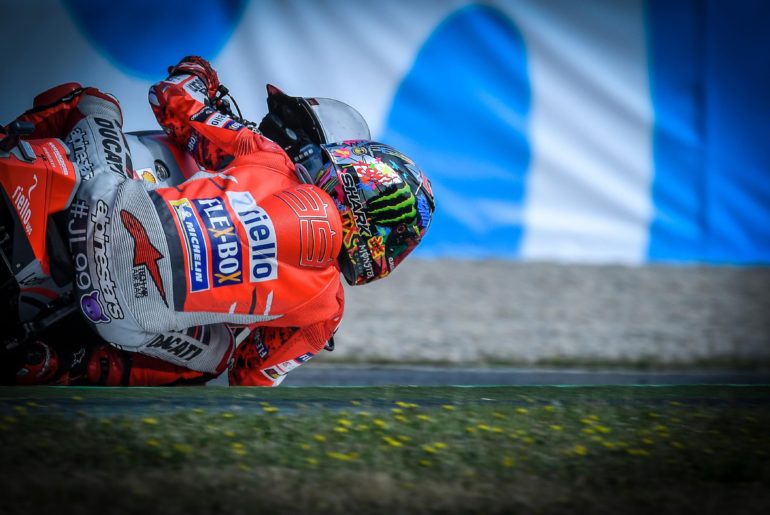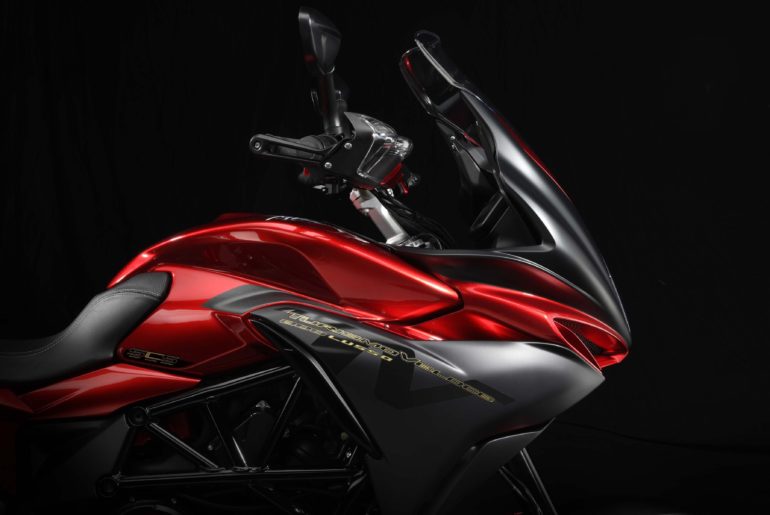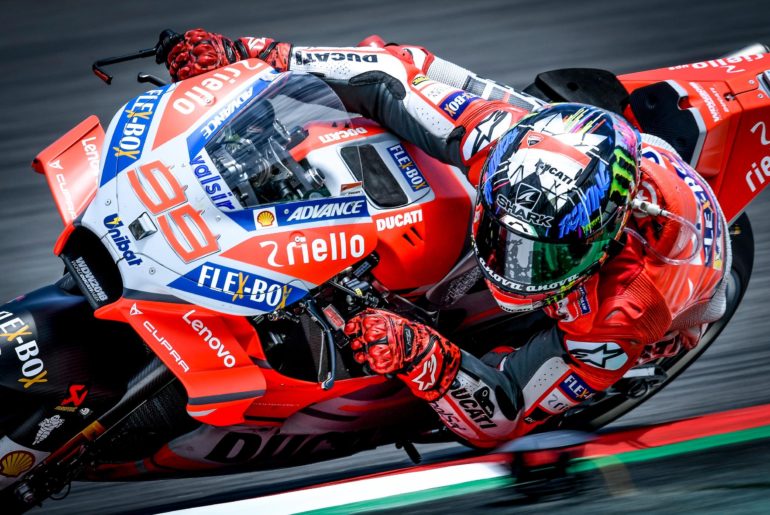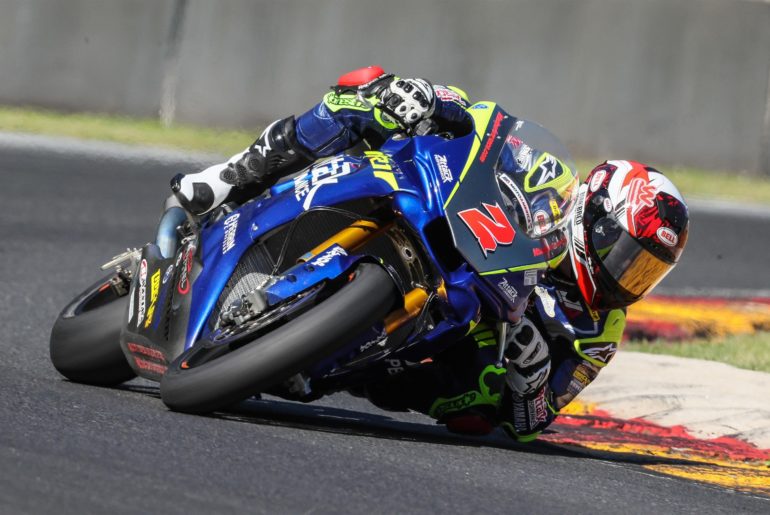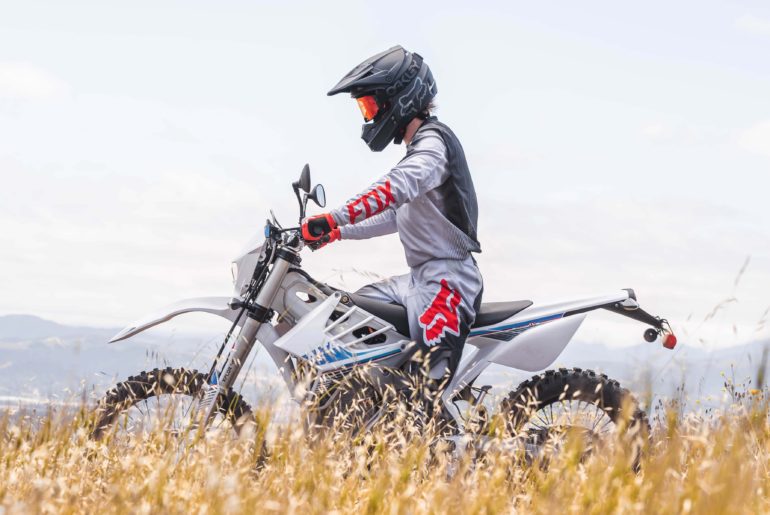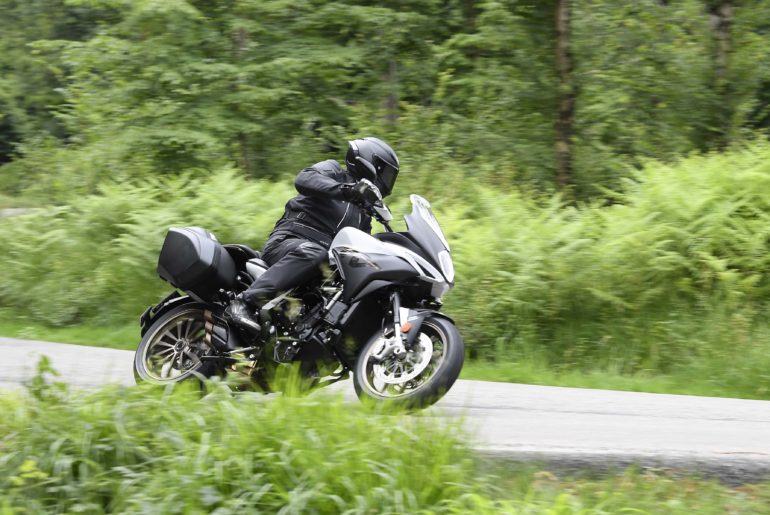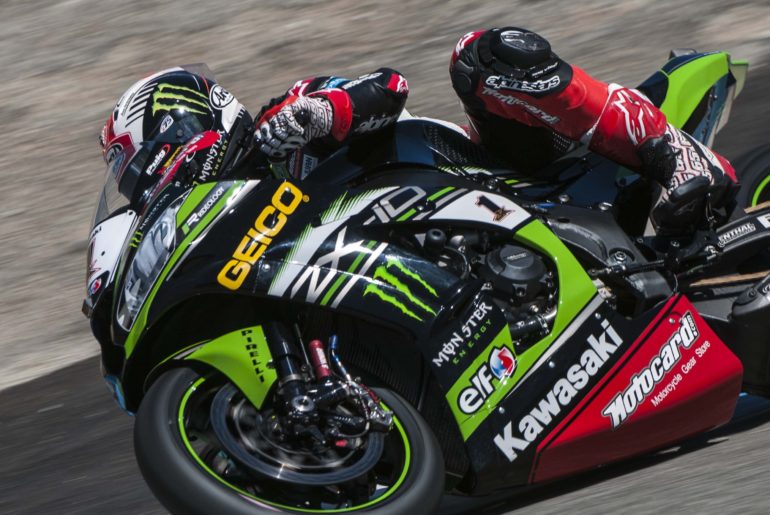The only motorcycle in MV Agusta’s lineup with a tall windscreen, bags, and a passenger seat designed for a human, it would be easy to call the Turismo Veloce 800 Lusso a sport-tourer or an adventure-sport, and indeed we do.
But for the Italian brand, the MV Agusta Turismo Veloce 800 Lusso is treated like a sport bike…a sport bike that one can ride all day, with bags and a pillion, if you so choose.
It seems like a fine distinction, or perhaps even splitting hairs, but in reality it is a subtle nuance that shows how MV Agusta thinks of its business, what sort of motorcycles it wants to produce, and for which riders it has in mind when it produces them.
Riding the Turismo Veloce 800 Lusso near MV Agusta’s factory in Varese, Italy, Asphalt & Rubber got to see first-hand how this “sport bike with bags” works in the real world.
And while the motorcycle looks no different from the last time we saw it, at the base model’s press launch in the South of France, there have been subtle changes to refine the Turismo Veloce, and to make it compliant with Euro4 regulations.
Getting now to see the premium “Lusso” trim level, as well as MV Agusta’s new “Smart Clutch System”, there was plenty to try on this motorcycle, and while we have a few criticisms, the result with the MV Agusta Turismo Veloce 800 Lusso is an ideal machine, if you could only own one motorcycle in your garage. Let me explain.
Changes from Euro4

Before we get too far into the review, I want to highlight quickly the many changes and refinements that the MV Agusta Turismo Veloce 800 Lusso has seen since this model was initially announced.
The biggest change of course has been the homologation to Euro4 emission standards, but MV Agusta has also put a lot of time and energy into its three-cylinder engines, in an effort to make them more reliable and more enjoyable to ride.
The biggest change comes to the engine’s cylinder head, with extensive work done to the valvetrain, including changing the profile of the cams, as well as the valves themselves and the valve guides getting a change in material.
A harmonic damper has also been added to the cylinder head, in an effort to reduce noise emissions.
That, coupled to the new exhaust muffler, has allowed MV Agusta to reduce the noise enough from the tailpipe and chassis of the motorcycle, which has allowed the Italian brand to increase the noise from the intake, giving riders the noise they want, while also giving the government regulators the noise they don’t want.
The balancing shaft for the three pistons has also been redesigned, as has the entire gearbox, which features a new primary ratio and is easier to shift.
MV Agusta says that the new gearbox is also quieter, again as the Italian brand looks for places where decibels can be sacrificed so gains can be found at the intake.
It is also worth mentioning that operational improvements have been made to the sprag clutch and oil pump, helping address two weak points in the previous design.
MV Agusta says that is has done all this without having to touch the powerband on the Turismo Veloce, though the quoted 110hp and 59 lbs•ft of torque is noticeably less than the 125hp and 62 lbs•ft that was told at the model’s debut in 2013.
That being said, MV Agusta’s boast of having the best power-to-weight ratio in class still remains true.
A Sport Bike That Tours

It is a bit of marketing speak to call the MV Agusta Turismo Veloce 800 Lusso a sport bike that tours, let us note that concept at the front.
A sport-tourer, an adventure-sport, whatever you want to call it, this is a road bike that is meant to get you some distance down the road – that road being the long and twisty way to your destination.
Based off MV Agusta’s 798cc three-cylinder engine that powers the Brutale and its kin, the Turismo Veloce takes that potent platform and adds a seat with real padding, integrated bags that are narrower than the handlebars, a useful windscreen, and a bevy of other pieces to make touring easier.
The real heart of the machine though is its sport bike roots, however. The three-cylinder engine is peppy off the line, with a meaty rev-range. The power trails off as you climb to the red line though, at which point the bike begins to show its 110hp rating.
For all the torque the triple shows down low and in the middle of the tachometer, the Turismo Veloce is still very much a middleweight in this larger category of sport-tourers. And a middleweight it is, with a paltry 423 lbs quoted (dry).
Not having our scales on us, it is hard to say how much the MV Agusta Turismo Veloce 800 Lusso weighs in reality, but the bike feels light and nimble when you ride it. It is a scalpel, and the apexes ahead are the patient on the table. Cut away my dear friends, cut away.
Side-to-side transitions are helped by the high perch on the seat, and the extra wide bars. The rider triangle is comfortable and upright, and only a touch sporty.
The Sachs semi-active suspension works well enough, though it should be noted that it only adjusts the damping settings on the forks and rear shock, not the preload as well. You can set the rear shock preload easily enough though, with a couple cranks of the hand below the seat.
Braking on the MV Agusta Turismo Veloce 800 Lusso is phenomenal, courtesy of Brembo, with ample front-brake power and feel. The rear brake was more of a disappointment however, and exactly the opposite on the two bikes we tested.
Points also get deducted for not allowing ABS to be turned off for the rear wheel only – an enjoyable feature for those who have an inner child and listen to loud music.
In creature comforts though, MV Agusta betrays the fact that they actually do know how to make a comfortable seat, as the Turismo Veloce 800 Lusso is quite forgiving on the rump. The windscreen can be operated with one hand; there is cruise control as well as a speed-limiter; and there is bluetooth connectivity – though we had a bit of trouble using it.
Still, out of all the bikes in the MV Agusta lineup, the Turismo Veloce 800 Lusso feels the most refined.
The dash is a color LCD panel, again the only one in MV Agusta’s lineup; the lines of the bike are clean, with cords and cables tucked away; and the electronics are fully sorted – which includes what I would call the best up/down quickshifter on the market.
SCS – Smart Clutch System

With the debut of the 2019 MV Agusta Turismo Lusso comes the latest technology from the Italian brand, the “Smart Clutch System” or SCS. Developed in conjunction with Rekluse, the auto-clutch is a first for the sport bike market, though the technology has been popular with off-road riders for many years now.
When coupled to MV Agusta’s up/down quickshifter system, the Smart Clutch System all but eliminates the need to use the clutch lever, with riders only needing to use the clutch in order to start the motorcycle.
Though debuting on the Turismo Veloce, MV Agusta has made no secret about the fact that SCS will come to other bikes in the brand’s lineup.
In application, the SCS is a mixed bag for street riders. Its immediate application isn’t obvious, especially with the level of electronics already on-board MV Agusta’s motorcycles, but the technology might be more relevant with city commuters and two-up tourers.
On the MV Agusta Turismo Veloce 800 Lusso SCS – try saying that three times fast! – the most obvious benefit comes in city traffic, of which we had plenty in Varese. Not needing to modulate the clutch can be a lifesaver when you are inching your way through cars and making low-speed maneuvers.
The technology works as advertised, though it can be rough around the edges. I experienced several low-speed stalls, which MV Agusta attributed to vapor lock, while several other colleagues complained of false neutrals while on the SCS bike.
I also found the quickshifter actuation more difficult and notchy on the SCS equipped model, which is unfortunate for MV Agusta, because the Italian brand makes using a quickshifter such a sublime experience.
Additionally, I found that during accelerations that the engagement of the clutch wasn’t always as smooth and linear as one would expect, with the SCS mechanical parts and the MVICS electronics seemingly having a difficult time applying the correct clutch pressure for the bike’s speed and engine RPM.
It seems oxymoronic to describe such a sensation as something that suffers from a lack of clutch feel, but that is the analogy that will best describe the effect to seasoned riders.
Minor issues aside, the real killer app for the Smart Clutch System might be with the touring crowd, which makes its debut on the MV Agusta Turismo Veloce 800 Lusso seem like a smart choice from the Italian brand.
Able to eliminate the helmet-jarring lurch that often comes from an abrupt start, SCS could be a passenger’s best friend. Similarly for the rider, not having to modulate the clutch with a passenger and luggage onboard can make riding two-up a more enjoyable and approachable experience.
Surely to get better with time, it will be interesting to see how this space develops, and to see how MV Agusta applies this technology to other bikes in its lineup.
For our wallets though, the $2,000 premium that SCS creates is perhaps not worth it for the marginal benefits and minor annoyances the auto-clutch brings. That being said however, the clear clutch cover is a delicious touch.
Ultra-Premium?

A solid machine with strong highlights and few weaknesses, in the end it is the price tag on the MV Agusta Turismo Veloce 800 Lusso that will be the biggest deal-breaker for would-be buyers.
The base model is priced at $17,498 in the USA, with the Lusso at $19,998 and the Lusso SCS at a whopping $21,998 MSRP.
This makes the Turismo Veloce one of the most expensive sport-touring / adventure-sport motorcycles on the market, in any sub-segment, especially when you consider the still unreleased “RC” variant that is surely going to climb close to $25,000 at MSRP.
This pricing strategy though fits with MV Agusta’s desire to be the ultra-premium motorcycle brand on the market, and the Italians have made no secret about their focus on smaller volumes, which this price tag is surely going to create.
Still for a 800cc motorcycle, such a price point strategy is difficult to swallow, especially when you look at the refinement and features that come with this machine, or lack thereof.
To be the ultra-premium brand that it wants to be, MV Agusta needs to be more than a good engine, a solid chassis, and a stunning design. These are elements that other brand replicate on a yearly basis. Instead, MV Agusta needs to lead and innovate.
With the MV Agusta Turismo Veloce 800 Lusso, the Italian brand has made great strides in improving its overall quality and user experience, but there is still considerable work to be done.
Items like the dash and switchgear continue to be generations behind the competition (and I continue to complain about them in my reviews), and there are nitpick items like the cheap-looking stickers badges that we find distracting to overall machine on the Turismo Veloce.
Items that you would give other brands a pass on, one has to hold MV Agusta to a higher standard, as the brand itself demands such a high-standard already.
That being said, the MV Agusta Turismo Veloce 800 Lusso is perhaps the finest motorcycle we have ridden from Varese.
It does everything well, and there were many voices in our group of hard-nosed journalists for more time on this enjoyable machine. There perhaps can be no higher compliment.
The perfect all-rounder, if you had to put one motorcycle in your garage, the MV Agusta Turismo Veloce 800 Lusso might be it…which is a good thing, because you likely won’t be able to afford having anymore bikes once you buy it.











Photos: Milagro

